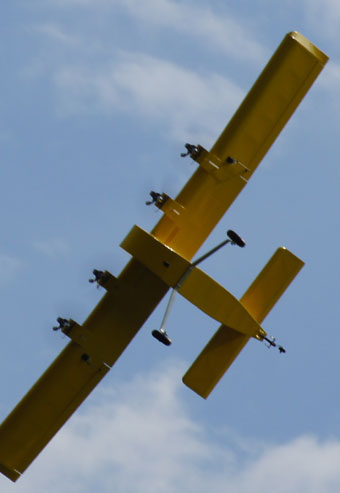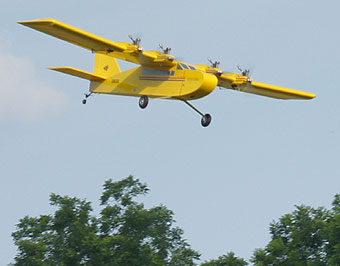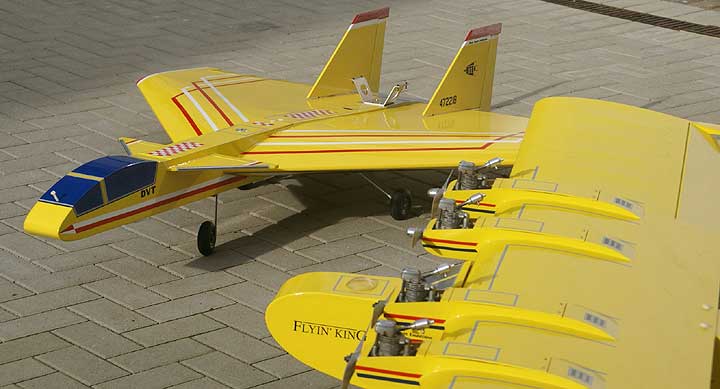

"The wing is coming along nicely. I can't believe it is 82 inches long! I have some concerns about the strength of the outer wing panel attachment to the nacelle. I added a second dihedral brace for strength. I'll tape the under side of the wing for additional strength. Hopefully that will provide ample structural strength for any type of maneuvers."
Later he wrote...
"The Flyin' King wing span is 82 inches. I'm using two OS.26FS engines on the inboard nacelles and two OS.20FS engines on the outer nacelles. Each nacelle has a 3 once tank and a mini-servo for the throttles. I'm sure it will fly as well as the standard kit."


"Have six flights on the four engine Flyin' King. It is easy to fly and has no bad habits. When an engine quits the plane yaws into the dead engine....once trimmed with rudder it continues to fly normally. I haven't fixed the down thrust problem yet....waiting to play with trim and engine settings to determine best throttle settings for flight. Full throttle is not necessary. It happily flies around with half throttle. I have lost two engines and it still flies along without a problem. The sound is quite distinct and pleasant to hear.
"I would recommend this conversion to others. The plane is a natural for modification. I like it so much I want to build a single engine version to play around with.."


"I've gone through one gallon of fuel flying the Flying King. I was able to lean out the engines this weekend. The strongest engine was turning above 13,000 rpm and the weakest about 11,500 rpm. I tuned all the engines to 11,000 rpm. The plane flies different with the extra power. My original fear of the plane being top heavy and nosing over has some merit. On one of flight I relaxed the back pressure on takeoff and the plane almost went nose first into the grass. So....I maintain back pressure on takeoff!
"I noticed it was climbing in turns. I'm so used to adding back pressure when entering a turn it happens without much thought. But with the engines mounted without down thrust, the thrust from the engines keeps the plane flying level when entering a turn. I've had to relearn and not add back pressure until the planes actually drops while in a turn. The lack of down thrust can be easily trimmed out but it is necessary to trim for each throttle setting. The answer is put some down thrust in the engines.
"The plane flies fairly straight but has a tendency to move obliquely away from you while flying left to right and toward you while flying right to left. I assume this is caused by not having right thrust on the engines. It is noticeable at all throttle settings. It is easily corrected by using rudder...and aileron when coming in for a landing. I've gotten used to this and pretty much ignore it.
"The engines are misers. The 3 ounce tanks are perfect for this plane/engine combination. I rarely fly with full throttle. It is most enjoyable at 60 to 80 percent throttle. With full throttle the plane is airborne in 100 feet or so. Landing are straight forward, requiring partial power to touch down. There is a lot of drag on the plane and it will slow down too fast if the throttles are pulled back to idle too soon. I fly straight and level only....won't chance aerobatics....just not worth damaging the plane.
"I enjoy flying the plane...and the sound is truly unique. The engines have been very reliable and don't need tuning on each flight. I just start them up and go fly. The exhaust smoke trail is easy to see and allows for a visual indicator of how the engines are tuned.
"As for my goal of using it to learn to fly a four engine model, it has been a complete success. Learning to manage the four engines so they remain running during flight has been a crucial step. Also, the planning required to modify a model for multi engines is very helpful for future projects. I would recommend this kind of modification to others. Flying the model is easy...that is mostly the choice in airframe. The Flying King is an excellent flying model and adding four engines didn't change that."
Bruce's comment: I am soooo jealous! Would love to have one for my own. I actually have an OS .20FS four-stroke engine in a vintage model and it's got a unique crackle at full throttle. Four of them running together would sound amazing. But the four-engined Flyin' King isn't Keith's only BTE kit bash. Check out his Delta Vortex (below) with canards and turbine power!
